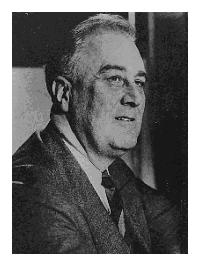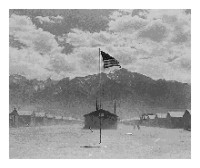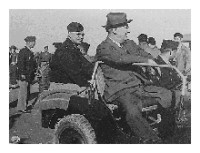
Troops from the United States and other Allied nations land on the beach at Normandy, France in 1944, beginning the western European invasion that would lead to defeat of Nazi Germany.
Sponsor this page for $100 per year. Your banner or text ad can fill the space above.
Click here to Sponsor the page and how to reserve your ad.
-
Timeline
1941 Detail
March 11, 1941 - The George Washington Carver Museum is dedicated at the Tuskegee Institute with the participation of such luminaries as Henry Ford. The museum is now part of the Tuskegee Institute National Historic Site.

By the date of the twenty-fifth anniversary of the founding of the Tuskegee Institute in 1881, the school had one hundred and fifty-six teachers, including one professor, George Washington Carver, whose legacy, which began at Tuskegee in 1896, would continue for decades in the fields of education, science, and invention.
George Washington Carver was thirty-two years old when he started teaching at the Institute. Born into slavery and kidnapped by raiders as an infant, Carver was raised, after gaining freedom after the Civil War, by the Missouri family who had previously owned him, and was urged toward education. He graduated from Iowa State College in 1894 with a degree in Agriculture, staying on as a faculty member while continuing his studies, and two years later received a Master's Degree, the first African American to achieve a Master's in Agricultural Science. On October 8, 1896, Carver joined the staff at the Tuskegee Institute as Head of Agriculture, recruited by Booker T. Washington.
During his years at Tuskegee, Carver was an inspired teacher, botanist, researcher, and artist, a man of diversified interests. Carver had won an award for his painting at the Chicago World's Fair of 1893. His goal as an educator was to instruct the children of former slaves as well as the poor farmers of the region in a land where cotton had exhausted the soil. He would devise the Jesup Wagon with T.M. Campbell on May 24, 1906, a Movable School Bus, to travel to poor regions of the state to conduct classes about agriculture with farmers. Carver pushed the local farmer to diversify their crops to protein rich crops such as peanuts and soybeans.
His research led to the establishment of three hundred products from peanuts, including peanut butter, salted peanuts, and peanut flour. Carver invented one hundred products from other southern crops, including sweet potatoes. George Washington Carver was also an environmentalist, devising techniques to replenish soils, that could assist in the profitability of farming.
By 1938, his life had been immortalized in the 1938 film, "Life of George Washington Carver," by the Pete Smith Specialty Company.

The Museum Opens
The George Washington Carver Museum would open on March 11, 1941. Dignitaries from around the nation, including Henry Ford, Sr., who had funded part of the museum, attended to honor Carver and his accomplishments. The museum contained paintings, experiments, and crops telling the story of the educator, agriculturist, and scientist.
The museum was established in a remodeled building that had been constructed in 1915.
Newspaper report from June 1, 1941, The Journal Herald, Ohio, by Irving A. Williamson
George Washington Carver Praised as Foremost Scientist By Irving A. Williamson
Late last month in Atlantic City 1,100 people witnessed the presentation of the 1940 Humanitarian award by the Variety Clubs of America to Dr. George Washington Carver, born of slave parents and once traded for a horse and who today is praised by many as the world's foremost scientist.
Modest Dr. Carver has heard many mean speak of his deeds and standing in the world of science. Henry Ford, in reply to a recent question as to whom he thought was the greatest living scientist, said: "George Washington Carver, of Tuskegee. He tops all men I know." Christy Borth in "Pioneers of Plenty," writes: "George Washington Carver, the first and greatest chemurgist."
The scientist was born a slave in Diamond Grove, Missouri, where when a child he and his mother were stolen and taken to Arkansas. He was ransomed from his captors with a horse valued at $300. His mother was never heard of again.
Worked His Way
As a gangling boy, determined to better his lot, he worked his way through public schools, received the degree of bachelor of science of agriculture from Iowa State college in 1894 and got his master's degree from the college in 1896. He was a member of the Iowa faculty a short while before going to Tuskegee Institute at Tuskegee, Ala., founded by the famed Booker T, Washington. At Tuskegee he is director of research and experiment and as such during, more than 40 years of research has given the south a new meaning of chemistry, agriculture a new outlook and industry a new alliance.
In 1896 Dr. Carver laid down his plan of attack on the farmers' problems of the south by five approaches to solution of them: Soil conservation, diversification of crops, live-at-home, finding new uses for farm crops and the utilization of native plants and farm crops.
Creative Research
Through his creative research Dr. Carver has found numerous uses that can be made of southern products and waste materials. From the clays of Alabama he has developed face powder, pigments, paints, stains, and has also demonstrated their value in ceramic work.
He has made the peanut yield over 300 products, including milk, cream, buttermilk, cheese, condiments, coffee, plastics, paper, stains and insulating boards.
The sweet potato has been productive of 118 products among which are starch, tapioca, mock cocanut, syrup, breakfast food and satins.
He has made paving blocks, insulating boards, cordage, paper and rugs from cotton. From plants generally regarded as weeds, many products have been created, as well as hundreds of dyes. Over 5,000 letters seeking information or expressing gratitude have been received by Dr. Carver In connection with his peanut oil treatment for the aftereffects of infantile paralysis.
Although Dr. Carver has a world-wide reputation as a scientist, he has received much recognition for his paintings. One of his paintings, "Three Peaches," was hung in the Luxembury gallery in Europe. He used pigments which he got from the clays of Alabama.
Many honors have come to Dr. Carver, including the Spingarn medal in 1923 for distinguished achievement, the unveiling of a bust of him at Tuskegee in 1937, but the greatest is probably the creation of the George Washington Carver foundation to carry on extensive research begun by Dr, Carver on the use of native southern plants, waste materials and the formulating of solutions of agriculture problems. Dr. Carver himself gave his life savings of $33,000 to the foundation for research and many others are expected to swell the endowment.

Visiting Tuskegee Institute National Historic Site and the George Washington Carver Museum Today
For those that wish to visit, the Tuskegee Institute National Historic Site is located at 1212 West Montgomery Road, Tuskegee Institute, AL 36088. It is free to visit. Besides the beautiful red brick building that houses the George Washington Carver Museum with the bust of Carver between its doors, the Tuskegee NHS includes Booker T. Washington's home, the Oaks, with ranger tours, as well as other buildings on campus that were built by original Tuskegee students and more.
The campus, a historic district in itself, holds Emery Halls, Millbank Hall (site of the original Carver agricultural experiments), the Food Science Building, Margaret Murray Washington Hall, Dorothy Hall, Tantum Hall, the Carver Research Foundation, among others. A stroll past these historic buildings provides great context to just how important the establishment of the university was in the progress of the United States and the education of minority students after the Civil War. And yes, its founding was established by those with good motives and imperfect pasts.
Several miles from campus, a National Historic Site dedicated to the Tuskegee Airman is located at Moton Field.
For another site devoted to the life of George Washington Carver, this in his home state of Missouri, is the George Washington Carver National Monument, located in Diamond, Missouri. It was founded in 1943 by President Franklin Delano Roosevelt, the first monument established to an African American and to a person that had not been a president.
Photo above: George Washington Carver, seated first row center, and staff, 1902, Francis Benjamin Johnston. Courtesy Library of Congress. Below: History class at the Tuskegee Institute, 1902, Frances Benjamin Johnston. Courtesy Library of Congress. Info Source: Tuskegee Institute; National Park Service; Library of Congress; newspapers.com; Wikipedia Commons.

History Photo Bomb

The campus, a historic district in itself, holds Emery Halls, Millbank Hall (site of the original Carver agricultural experiments), the Food Science Building, Margaret Murray Washington Hall, Dorothy Hall, Tantum Hall, the Carver Research Foundation, among others. A stroll past these historic buildings provides great context to just how important the establishment of the university was in the progress of the United States and the education of minority students after the Civil War. And yes, its founding was established by those with good motives and imperfect pasts.
Several miles from campus, a National Historic Site dedicated to the Tuskegee Airman is located at Moton Field.
For another site devoted to the life of George Washington Carver, this in his home state of Missouri, is the George Washington Carver National Monument, located in Diamond, Missouri. It was founded in 1943 by President Franklin Delano Roosevelt, the first monument established to an African American and to a person that had not been a president.
Photo above: George Washington Carver, seated first row center, and staff, 1902, Francis Benjamin Johnston. Courtesy Library of Congress. Below: History class at the Tuskegee Institute, 1902, Frances Benjamin Johnston. Courtesy Library of Congress. Info Source: Tuskegee Institute; National Park Service; Library of Congress; newspapers.com; Wikipedia Commons.








